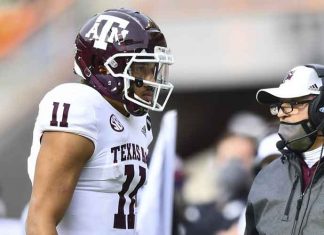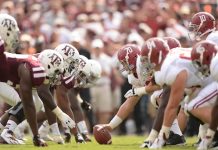For the college athletes who are heading into a season of uncertainty brought on by COVID-19, the NCAA’s decision to not charge them a year of eligibility – no matter how much they play – brings peace of mind.
And happy parents.
”My mom’s more excited about it than I am,” said running back Deshaun Fenwick, who is heading into his third year at South Carolina. ”When I call her later in the day she’s going to tell me I can stay and get my master’s.”
The decision does not come without complications. Paying for all those extra scholarships will be tricky for schools tightening budgets and some athletes might find their coaches aren’t so eager to welcome them back. Plus, the backlog of athletes cycling out of college could mean fewer opportunities for the next wave coming from high school.
”We’re trying to create flexibility like we’ve never seen in college athletics,” said South Dakota State athletic director Justin Sell, who is a member of the Division I Council.
College administrators have gone through this already. The recommendation made by the Division I Council earlier this week, and approved by the Board of Directors on Friday, mimics what was done in the spring after the pandemic canceled seasons in sports such as baseball, softball and lacrosse.
Seniors will be permitted to return next year and not count against a sport’s roster or scholarship limits. Underclassmen will get access to a waiver they can use to extend their careers, but beyond the 2021-22 academic year, those athletes will count against scholarship and roster limits. So Clemson junior quarterback Trevor Lawrence, who started as a freshman, could conceivably play a full 2020 season and two more.
And while the NCAA is giving back the eligibility, no athlete is guaranteed financial aid or a scholarship. Those decisions will be left to the schools.
The big difference between applying this model to fall and spring is football, where FBS teams can have up to 85 scholarship players and the FCS limit is 63. Those scholarship can range from $30,000 per year to pushing $80,000 at a private school like Notre Dame or Stanford. With colleges and their athletic departments facing massive revenue losses as a result of the pandemic, funding extra scholarships will be challenging.
”We may have some tough decisions, but we do all the time,” said Sell, whose school competes in the FCS Missouri Valley Football Conference.
Iowa of the Big Ten, which hopes to play football in the winter and spring, announced Friday it was discontinuing four sports: men’s tennis, men’s and women’s swimming and diving, and men’s gymnastics.
Major college football teams could end up with 100 or more scholarship players next season. The thought of bringing back a bunch of sixth-year seniors will bring smiles to some coaches – especially at programs that rely more on developmental players than blue-chip recruits who tend to be short-timers anyway.
”I know this, if we had every guy who could come back next year and did come back next year, we would have a really, really loaded group,” Cincinnati coach Luke Fickell said.
There are 257 Division I football programs (130 in FBS) that will start the 2021 fall season with, essentially, two freshmen classes, upward of 40 players who still have four years of eligibility left. There are no plans as of now to adjust scholarship limits after next year to address the clogged pipeline.
”I think anybody that knows the true workings of inside programs, these college program will run kids off,” said Nate Himerlich, football coach at Pickerington North High School in the suburbs of Columbus, Ohio. ”Kids will be transferring, going to lower levels.”
Eventually that could squeeze out high school players as college teams divert scholarships to players in the transfer portal or keep some tied up an extra year on players who want to cash in the 2020 eligibility they have in the bank.
What happens to the high school recruits as the scholarship opportunities shrink?
”You’re going to see junior college football really elevate,” said Chad Johnson, football coach at Mission Viejo High School in Southern California. ”Fast forward a year or two, there’s going to be colleges going through all the JCs to get those players that got caught in the in between because they can play right away and they’re good vs. recruiting high school kids.”
Currently, all but six Division I conferences have postponed fall football in the hope of having a spring season. The conferences still moving toward a fall season have no guarantees for their players either.
For the ones who were facing the prospect of having their final college seasons disappear, the NCAA’s decision provides a bit of certainty.
”I think it’s a good idea for all of the seniors to take advantage of it,” Georgia Tech senior punter Pressley Harvin said. ”It gives you more time to get ready for the next level also.”
—
Follow Ralph D. Russo at https://twitter.com/ralphDrussoAP and listen at http://www.westwoodonepodcasts.com/pods/ap-top-25-college-football-podcast/
—
More AP college football: https://apnews.com/Collegefootball and https://twitter.com/AP-Top25
25% Bonus via Western Union

















